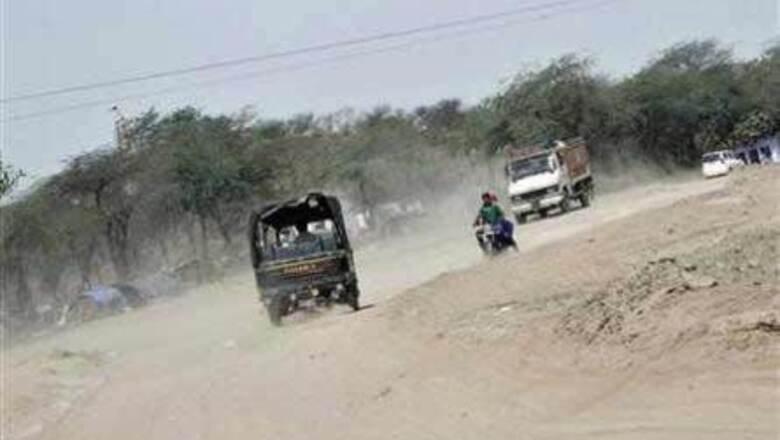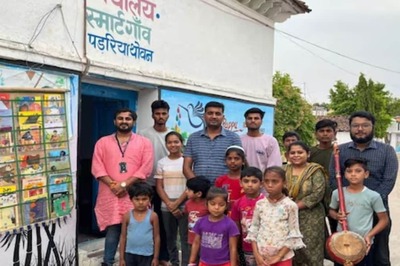
views
Ballia: In wheat field near the mighty Ganges river stands a cracked foundation stone surrounded by nibbling goats and farmers driving their cattle in the baking sun.
Unveiled more than four years ago, it's all that remains of an ambition to build India's longest expressway, an eight-lane, 1,050-km(650-mile) road that would have run through Uttar Pradesh and connected one of the country's most backward regions to the doorstep of the nation's capital.
Supporters of the Ganga Expressway project say it would have helped transform Uttar Pradesh, India's most populous state and one of its poorest and the lives of its 200 million people by slashing travel times and letting industry and townships sprout.
But having been in and out of the headlines for years, the project has all but crumbled under the weight of political wrangling, opposition from farmers whose fields would have suffered, and a court order in 2009 stalling construction on environmental grounds.
"It's one of those projects that can change the development map of a region," said Gopal Sarma of the consulting firm Bain & Company.
"At the same time, there is the whole issue of how do you deal with people who have held onto pieces of land for literally hundreds of years, and are not really looking at compensation but are looking to continue a way of life that they have had?"
The failure of the Ganga Expressway offers a snapshot of India's chronic infrastructure woes and a reality check on Prime Minister Manmohan Singh's recent promise to speed up more than 200 key projects.
New Delhi has set an ambitious target to pump $1 trillion into an overhaul of infrastructure over the next five years, revamping roads, building airports and tackling endemic power blackouts. But, as the Ganga Expressway shows, such targets are all too often held hostage to harsh realities on the ground.
It's also symptomatic of how, for India's leaders, political expedience often trumps the need to revive investor sentiment and growth. In recent months, one party in the ruling coalition blocked a proposal to open the retail sector to foreign investment and the government has dithered on slashing costly state subsidies on fuel, fertilisers and food.
"It was a very ambitious project," said a former top state official who was closely involved in the expressway proposal, speaking to Reuters on condition of anonymity. "The tragedy of the whole situation was that the politics came in.
"People don't know what is good for the state, good for the people, good for the country," the official added.
TREACHEROUS, MIND-NUMBING
Driving across Uttar Pradesh's existing highways can be by turns treacherous or mind-numbingly slow. Cars and trucks jostle with bicycles, bullock carts, cows and goats along what are often narrow and potholed roads, gumming up traffic and prompting drivers to veer dangerously across lanes to overtake.
With a creaking rail network, India relies heavily on such highways to transport goods. But their often-shoddy condition saps the competitiveness of companies and creates supply bottlenecks that have helped keep inflation uncomfortably high.
The average speed of trucks travelling on Indian roads is just 35 km(22 miles) per hour, less than half the 75 km(47 miles) in the United States, according to a report by global management consultancy McKinsey and Company.
The Ganga Expressway was supposed to help change all that. Conceived under Mayawati, a four-time chief minister of Uttar Pradesh with prime ministerial ambitions, the stone was unveiled with much fanfare on her 52nd birthday in January 2008.
A contract to build the road was awarded to a unit of Jaiprakash Associates, a construction and infrastructure giant that also built India's Formula One track. Sameer Gaur, a top executive at the group who led the project, declined to comment for this article.
Under the state government's proposal, the company was to both fund and build the project. In return, it could charge toll fares and develop potentially lucrative real estate along the road - a version of the public-private-partnerships(PPP) that cash-strapped Indian governments have pushed in the sector.
But as is so often the case in India's troubled infrastructure story, one person's key development project is another person's land grab.
Farmers, egged on by what was at that time the state's main opposition Samajwadi Party(SP), said the project would rob small landholders of fertile land and their livelihoods.
Grumbling about inflation, power and water shortages, the farmers have scant faith in politicians and struggle to see how a massive highway running over their lands would benefit them.
"The government has done nothing for us except raise prices," said one, Dinesh Rai. "We are fooled by every party that comes in."
"What are we going to sell if we can't grow anything? What will we carry along an eight-lane road? Mud?" joked another, Jitender Kumar Yadav.
The SP, which booted Mayawati out of office in state elections in March, called the project a conspiracy and staged protests.
Ambika Chaudhary, the revenue minister in the new government, proudly told Reuters his activists, then in opposition, caused such a furore that Mayawati scrapped a planned trip to lay the foundation stone in 2008. Instead, she unveiled it at the state capital, Lucknow, and later had the stone transported to its current location.
"She did not dare to come to Ballia," Chaudhary said. "We protested like anything and the programme was cancelled."
BRAKES
Officially, the Ganga Expressway still exists on paper, but with SP in power in Uttar Pradesh, it is unlikely to be built, at least for years.
Across India, poor infrastructure has helped put the brakes on the once-stellar growth of Asia's third-largest economy, which has dropped to its slowest pace in nine years, and businesses are clamouring for more policy action.
Lacking the financial muscle that China has to bring its infrastructure up to speed, New Delhi has turned to the private sector to fund half of the $1 trillion target.
But time after time, big investments fall prey to red tape and battles over land, stalling projects for years. Firms complain bureaucracy and corruption delay the awarding of contracts, while debt to fund new ventures is scarce and the market in which to bid for them too aggressive.
As a result, New Delhi has consistently missed construction and funding targets for many sectors in recent years. Out of 583 projects worth more than 1.5 billion rupees each, 235 are delayed, according to the government's 2011-12 economic survey.
Roads are the worst hit, although the $8 billion Golden Quadrilateral project, that links big cities New Delhi, Mumbai, Kolkata and Chennai with modern highways, has been mostly completed.
Examples abound of projects hit by similar woes to the Ganga road. The KMP Expressway, aimed at slashing congestion in the capital, was meant to be completed a year before the 2010 Commonwealth Games in Delhi. Instead, land disputes and delays in obtaining clearances caused it to miss several deadlines and it is now scheduled to be finished next May.
Bain's Sarma estimates that India will only achieve about $650 billion of the $1 trillion target, and that number could fall further if the government fails to lift corporate sentiment with some key policy decisions over the next 3-6 months.
"We still are facing huge policy paralysis to get projects moving forward. Project pipelines are slow," he said.
Facing an avalanche of criticism over his government's handling of the economy, Singh has raised infrastructure targets and rolled out a system to track key projects.
A senior government adviser, speaking on condition of anonymity, said the renewed push would help make individual ministries more accountable on performance, but added that he didn't "expect miracles".
For now, infrastructure players will likely wait and see whether Singh can deliver on his promise of a new impetus.
"(We're) not too optimistic, to be frank with you, because it is not the first time that such intentions have been made public," Vinayak Chatterjee, the chairman of Feedback Infrastructure Services, told Reuters Television.
"But I think there is a sense of fatigue with mere announcements of targets or mere announcements of new projects."



















Comments
0 comment